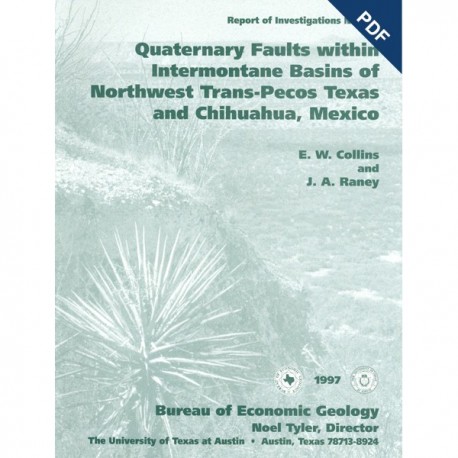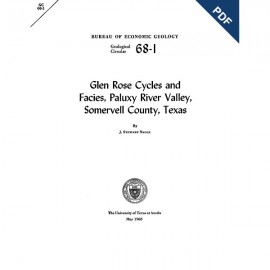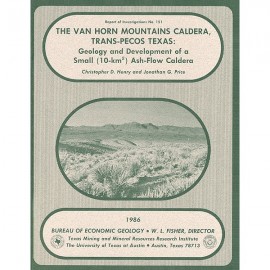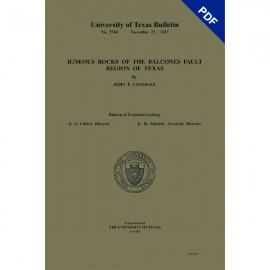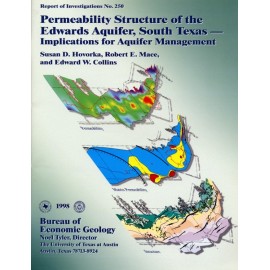Reports of Investigations
-
Books & Reports
- Reports of Investigations
- Guidebooks
- Udden Series
- Geological Circulars
- Down To Earth
- Atlases of Major Oil and Gas Reservoirs
- Texas Memorial Museum Publications
- Environmental Geologic Atlas of the Texas Coastal Zone
- Mineral Resource Circulars
- Other Reports
- Seminars and Workshops
- Handbooks
- Submerged Lands of Texas
- Symposia
- Annual Reports
- Open File Reports
-
Maps & Cross Sections
- Thematic Maps
- Miscellaneous Maps, Charts & Sections
- Geologic Atlas of Texas
- STATEMAP Project Maps
- Geologic Quadrangle Maps
- Cross Sections
- Highway Geology Map
- Energy and Mineral Resource Maps
- Shoreline Change and Other Posters
- Wilcox Group, East Texas, Geological / Hydrological Folios
- Bouguer Gravity Atlas of Texas
- River Basin Regional Studies
- Featured Maps
- Posters
- Teachers & the Public
-
Geological Society Publications
- Gulf Coast Association of Geological Societies
- Alabama Geological Society
- Austin Geological Society
- Corpus Christi Geological Society
- Houston Geological Society
- Lafayette Geological Society
- Mississippi Geological Society
- New Orleans Geological Society
- South Texas Geological Society
- GCS SEPM Publications
- Historic BEG & UT Series
Quaternary Faults within Intermontane Basins of Northwest Trans-Pecos Texas and Chihuahua, Mexico. Digital Download
RI0245D
For a print version: RI0245.
RI0245D. Quaternary Faults within Intermontane Basins of Northwest Trans-Pecos Texas and Chihuahua, Mexico, by E. W. Collins and J. A. Raney. 59 p., 31 figs., 2 tables, 1997. doi.org/10.23867/RI0245D. Downloadable PDF.
To purchase this publication in book format, please order RI0245.
About This Publication
This report details the occurrence, geometries, scarp morphology, and paleorupture histories of Quaternary faults of northwest Trans-Pecos Texas and northern Chihuahua, Mexico.
ABSTRACT
This study area encompasses a part of the east margin of the Southern Basin and Range-Rio Grande rift tectonic province. Pre-Cenozoic tectonism and its influence on the Cenozoic structural history is also reviewed. Basins studied include the Hueco, Red Light, Northwest and Southeast Eagle Flat, Green River, Salt, Wild Horse, Lobo Valley, and Ryan Flat Basins. Aerial photographs and outcrops were analyzed in conjunction with borehole and seismic data to evaluate the region's structural and stratigraphic framework and the attributes of the Quaternary faults.
Regional Cenozoic extension produced northwest- and north-northwest-trending, fault-bounded basins and adjacent mountain ranges that were superimposed upon preexisting Tertiary, Mesozoic, and older tectonic features. Similar strikes of pre-late Cenozoic structures and the superimposed late Cenozoic basins and faults indicate that the preexisting structural grain influenced geometries of the late Cenozoic basins and associated faults.
The Hueco Bolson, the most tectonically active Cenozoic basin of the region, locally contains as much as 3 km of fill. Other basins contain less than 900 m of Cenozoic basin fill. Evidence of Quaternary tectonism is recorded by displacement of middle and upper Pleistocene deposits across range-bounding and intrabasinal faults. Middle Pleistocene displacement varies from less than 1 to 32 m. The larger displacement faults vertically offset upper Pleistocene deposits between 1 and 6 m. For some of these faults, early Holocene fault movement is likely, although not precisely dated. Even on the most active faults, average slip rates since the middle Pleistocene are low, at less than or equal to 0.1 mmlyr. Maximum vertical displacements during large surface rupture events were between 0.5 and 3 m. Average recurrence intervals since the middle Pleistocene of large surface ruptures are relatively long--15,000 to 160,000 yr, although faulting events are probably episodic.
Knowledge of structural setting and Quaternary tectonism of these basins and associated faults provides clues about these basins' structural development, as well as the structural history of the southeast margin of this extensional tectonic province. These studies are also useful in seismic risk studies related to designing critical facilities such as the proposed Eagle Flat low-level radioactive waste repository.
Keywords: faults, neotectonics, paleotectonics, Quaternary, seismic risk, Southern Basin and Range-Rio Grande rift, tectonics, Trans-Pecos Texas
CONTENTS
Abstract
Introduction
Location and Methods
Previous Work
Geologic Setting
Quaternary Stratigraphy
Historical Earthquakes
Cenozoic Basins and Quaternary Faults
Hueco Bolson
East Franklin Mountain Fault
Hueco Fault Zone
Campo Grande Fault Zone
Arroyo Diablo Fault
Caballo Fault Zone
Amargosa Fault Zone
Acala Fault
Arroyo Macho Fault
Ice Cream Cone Fault
Schroeder Fault
Red Light Bolson
West Eagle Mountains-Red Hills Fault
West lndio Mountains Fault
Nick Draw Fault
Northwest Eagle Flat Basin
Southeast Eagle Flat Basin
West Van Horn Mountains Fault
East Eagle Mountains Fault
Green River Basin
lndio Fault
China Canyon Fault
Green River Fault
Salt Basin Graben System
Border Fault Zone
West Delaware Mountains Fault Zone.
Dell City Fault
East Flat Top Mountains Fault
North Sierra Diablo Fault
East Sierra Diablo Fault...
East Carrizo Mountains-Baylor Mountain Fault
Fay Fault
Neal Fault
Mayfield Fault
Sierra Vieja Fault
West Wylie Mountains Fault
Deep Well Fault
Possible Quaternary faults in Chihuahua, Mexico
Summary
Pre-Cenozoic Structural Grain and Cenozoic Basins
Quaternary Fault Occurrence and Rupture Attributes
Acknowledgments
References
Figures
1. Regional map of Cenozoic basins and Quaternary faults, northwestern Trans-Pecos Texas and adjacent Chihuahua, Mexico
2. Map showing major regional tectonic features of West Texas and adjacent areas of New Mexico and Mexico
3. Generalized map of Paleozoic tectonic setting
4. Generalized map of Mesozoic-Laramide tectonic setting
5. Map showing location and basin-fill thicknesses of Cenozoic basins, northwestern Trans-Pecos Texas
6. Chart showing Quaternary stratigraphy, northwestern Trans-Pecos Texas and south-central New Mexico
7. Map showing Quaternary faults, northwest Hueco Bolson
8. Map showing Quaternary faults, southeast Hueco Bolson
9. Photograph of scarp of East Franklin Mountains fault
10. Photograph of probable scarp of North Caballo fault
11. Photograph of South Caballo fault
12. Photograph of outcrop view of Northwest Amargosa fault
13. Maps showing section boundaries of Northwest Amargosa fault, Central Amargosa fault, and Southeast Amargosa fault
14. Maps showing fault-strand boundaries along the Amargosa fault zone
15. Photograph of distinct scarp of Amargosa fault zone, aerial view
16. Southwest-northeast cross sections showing faulting of Quaternary gravel deposits at the Ice Cream Cone fault and structural relationship of the Schroeder fault, Ice Cream Cone fault, and South Caballo fault
17. Map showing Quaternary faults, Red Light Bolson
18. Photograph of landslide--slump faults of the Washboard Hills area, Red Light Bolson, aerial view
19. Log of trench excavated across the West Eagle Mountains-Red Hills fault
20. Photograph of scarp of West lndio Mountains fault
21. Map showing Quaternary and distinct, late Tertiary faults, northwest Eagle Flat, southeast Eagle Flat, and Green River Basins
22. Photograph of north part of West Van Horn Mountains fault (fault 9), aerial view
23. Map showing Quaternary faults, Salt Basin graben system
24. East-west scarp profiles and outcrop descriptions of the north strand of the East Sierra Diablo fault
25. Photograph of scarp of north part of East Sierra Diablo fault
26. Photograph of Neal fault, a range-bounding fault along the eastern base of the Van Horn Mountains, aerial view
27. Photograph of scarp of Neal fault
28. Photograph of scarp of Mayfield fault, where resistant limestone bedrock crops out along scarp face
29. Northeast-southwest profile and outcrop descriptions of Mayfield fault
30. Southwest-northeast cross sections of Lobo Valley basin and along Van Horn Creek valley showing local obsequent fault-scarp expression of Mayfield fault
31. Photograph of scarp of Sierra Vieja fault (fault 16c)
Appendix Tables
Table A-1. Geometric characteristics of faults that offset Quaternary deposits
Table A-2. Fault-displacement characteristics of faults that offset Quaternary deposits
Citation
Collins, E. W., and Raney, J. A., 1998, Quaternary Faults within Intermontane Basins of Northwest Trans-Pecos Texas and Chihuahua, Mexico: The University of Texas at Austin, Bureau of Economic Geology, Report of Investigations No. 245, 59 p. doi.org/10.23867/RI0245D.
